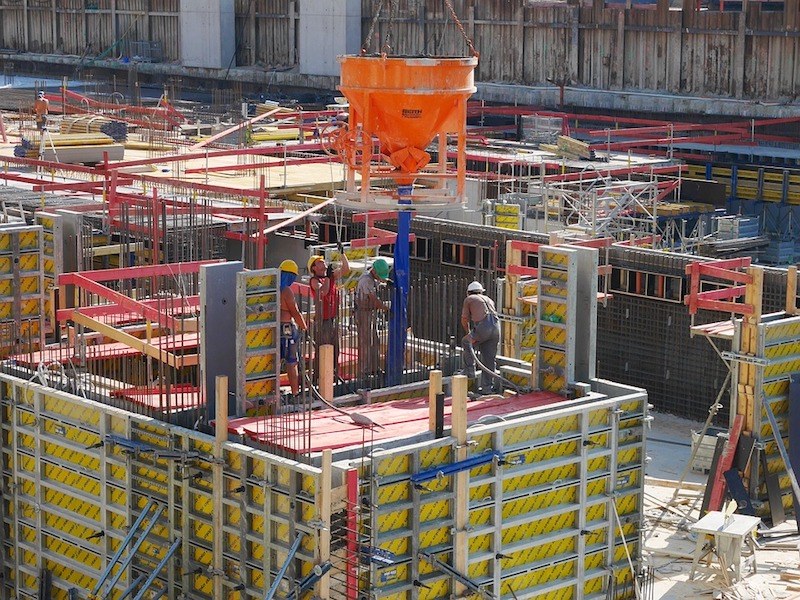Strong construction momentum will easily carry through the first half of 2019, despite project margins facing pressure from all sides. JLL’s Construction Outlook finds robust U.S. economic fundamentals will drive further growth of the sector, which in 2018 recorded a 5.1% increase in total construction value and a 4.5% increase in employment.
Potential risks to the construction sector such as trade war escalation, deteriorating macroeconomic conditions and the worsening labor shortage, are largely balanced by potential boosts that include a large-scale federal infrastructure package, relief from tariffs and the continuation of 3.5% annual GDP growth.
“All forward indicators for construction are still flashing green,” said Todd Burns, President, Project and Development Services, JLL Americas. “However, a year with growth equal to that of 2018 would be considered a success, given concerns of a broader economic slowdown.”
Rising construction costs will sideline select projects
Total building costs, which includes labor, materials and equipment, grew by 3.4% in 2018, outpacing the U.S. inflation rate of 1.9%. The widening spread between cost growth and inflation is pushing borderline projects past the threshold of profitability. Building costs will continue to increase in 2019 but at a slower rate than 2018. This reflects an expected cooldown in material pricing but the surging cost of labor.
Growth in total construction employment has hovered between 3 and 6% over the past six years – a far cry from what’s required for labor supply to catch up with demand. With a tight national employment market, the situation is unlikely to improve anytime soon. Construction wage growth in 2019 will top the 3.4% increase seen last year.
Trade policy a powerful “swing” force
With a direct impact on commodity prices, tariffs represent a uniquely immediate threat to an industry that typically moves slowly. Given the well-established political willingness to impose tariffs and the widening trade deficit with China, a continuation of tariffs in 2019 is expected.
The biggest chance for relief from tariffs are international trade deals that would lift tariffs in exchange for other trade or economic concessions. Such a deal could represent a dramatic positive for construction and is a potential bright spot for the industry.
Construction tech in growth mode, presents opportunity for labor shortage relief
The buzz around construction technology has long eclipsed actual adoption in the industry. The past year, however, saw meaningful gains fueled by large general contracting firms racing to improve productivity and remain competitive. High levels of tech adoption will spread to smaller firms, and elements of construction tech will become the standard across the industry in 2019. Amid intense labor pressures, contractors’ most common reason for making technology investments is to increase labor productivity.
Modular construction is poised to have the biggest long-term impact on the industry. Proponents of the technology envision a future full of dedicated warehouses churning out modular components – from exterior wall segments to entire apartment units – for most new construction.
“Adopting modular construction is not always as simple as it sounds,” said Henry D’Esposito, Senior Research Analyst, Project and Development Services, JLL. “There is often a prolonged period during which the benefits are not fully realized, as firms take time to adjust to the new system. Despite some of the initial challenges, there has been no hesitation among contractors about whether modular will continue to grow.”
Growth of modular construction in 2019 will be centered around increased use by select sectors, including hospitality and healthcare, and an increase in use for one or two select elements within a broader array of projects.
Related Stories
Market Data | Feb 4, 2016
Mortenson: Nonresidential construction costs expected to increase in six major metros
The Construction Cost Index, from Mortenson Construction, indicated rises between 3 and 4% on average.
Contractors | Feb 1, 2016
ABC: Tepid GDP growth a sign construction spending may sputter
Though the economy did not have a strong ending to 2015, the data does not suggest that nonresidential construction spending is set to decline.
Data Centers | Jan 28, 2016
Top 10 markets for data center construction
JLL’s latest outlook foresees a maturation in certain metros.
Market Data | Jan 20, 2016
Nonresidential building starts sag in 2015
CDM Research finds only a few positive signs among the leading sectors.
Market Data | Jan 20, 2016
Architecture Billings Index ends year on positive note
While volatility persists, architecture firms reported healthy performance for 2015.
Market Data | Jan 15, 2016
ABC: Construction material prices continue free fall in December
In December, construction material prices fell for the sixth consecutive month. Prices have declined 7.2% since peaking in August 2014.
Market Data | Jan 13, 2016
Morgan Stanley bucks gloom and doom, thinks U.S. economy has legs through 2020
Strong job growth and dwindling consumer debt give rise to hope.
Hotel Facilities | Jan 13, 2016
Hotel construction should remain strong through 2017
More than 100,000 rooms could be delivered this year alone.
Market Data | Jan 6, 2016
Census Bureau revises 10 years’ worth of construction spending figures
The largest revisions came in the last two years and were largely upward.
Market Data | Jan 5, 2016
Majority of AEC firms saw growth in 2015, remain optimistic for 2016: BD+C survey
By all indications, 2015 was another solid year for U.S. architecture, engineering, and construction firms.















